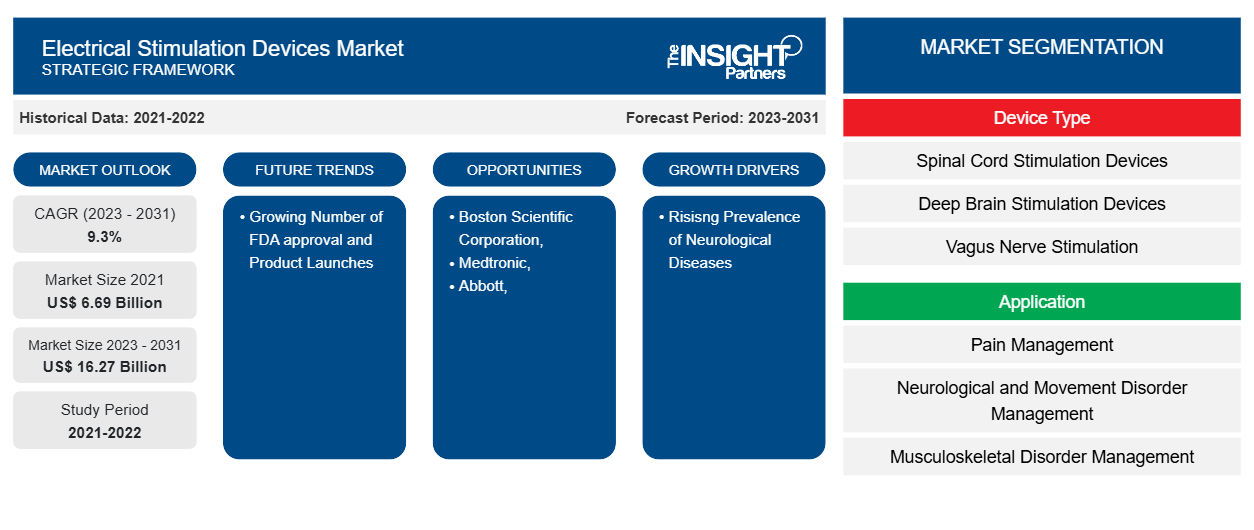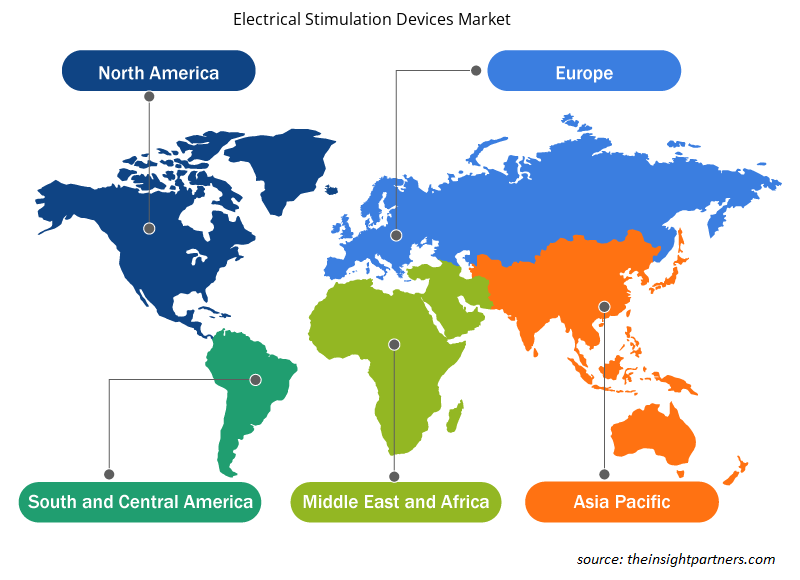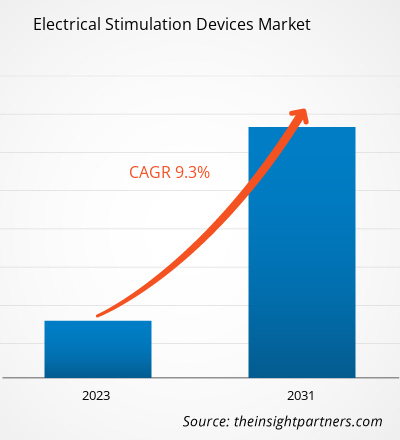The electrical stimulation devices market size was estimated to be US$ 6.69 billion in 2021 and US$ XX billion in 2023 and is expected to reach US$ 16.27 billion by 2031. It is estimated to record a CAGR of 9.3% till 2031. Rising prevalence of neurological diseases, rising prevalence of chronic diseases and wearable electrical stimulation devices are likely to remain key electrical stimulation devices market trends.
Electrical Stimulation Devices Market Analysis
Chronic pain is a comples and debilitating pain condition that affects millions of people worldwide. The pain is defines that last more than 12 weeks, and persists for month or even year. Some of the common cause of chronic pain are injury, trauma, arthritis, nerve damage including others. Such pain also affects the daily socio and economic lives of patients. Growing prevalence of chronic pain is expected to device the growth of the market. As per centre of diseases control and prevention, during 2021, an estimated 20.9% of US adults experienced chronic pain, which was same as reported estimate of 20.4% in 2016. Chronic pain conditions mainly include the pain of back, knees, and arms, as well as other musculoskeletal conditions. Electrical stimulation devices have capability to reducing the pain to considerable extent. These benefits of electrical stimulation devices, coupled with increasing prevalence of chronic pain, drives the growth of the electrical stimulation devices market.
Electrical Stimulation Devices Market Overview
The growth of the market is attributed to some key driving factors such as rising prevalence of neurological diseases & chronic pain. However, high treatment cost of the devices is likely to show negative impact on market growth during the forecast period. Global electrical stimulation devices market is segmented by region into North America, Europe, Asia Pacific, Middle East & Africa and South & Central America. The largest market for the electrical stimulation devices is held by the North American region. The factors that are influencing the market growth include rising research and development activities, growing financial investments by market players, and growing adoption of electrical stimulation devices within public and private organizations and within market players.
Customize This Report To Suit Your Requirement
You will get customization on any report - free of charge - including parts of this report, or country-level analysis, Excel Data pack, as well as avail great offers and discounts for start-ups & universities
Electrical Stimulation Devices Market: Strategic Insights

- Get Top Key Market Trends of this report.This FREE sample will include data analysis, ranging from market trends to estimates and forecasts.
You will get customization on any report - free of charge - including parts of this report, or country-level analysis, Excel Data pack, as well as avail great offers and discounts for start-ups & universities
Electrical Stimulation Devices Market: Strategic Insights

- Get Top Key Market Trends of this report.This FREE sample will include data analysis, ranging from market trends to estimates and forecasts.
Electrical Stimulation Devices Market Drivers and Opportunities
Rising Prevalence of Neurological Diseases Favor the Electrical Stimulation Devices Market
Neurological diseases represent substantial burden on health systems in terms of disease identification, treatment, and management. Several frequently observed neurological diseases comprises narcolepsy, Parkinson’s disease, Alzheimer’s disease, multiple sclerosis, spinal muscular atrophy (SMA), Duchenne muscular dystrophy, and others. A major new study released by The Lancet Neurology shows that, in 2021, more than 3 billion people worldwide were living with a neurological condition. Over the past few decades, there have been various research and development activities pertaining to the diagnosis and management of neurological diseases. Advancements in healthcare systems and modernizing diagnostic systems are likely to enhance the screening processes for rare neurological diseases. Such advancements, coupled with growing prevalence of neurological diseases, are driving the growth of the electrical stimulation devices market.
Growing Number of FDA Approvals and Product Launches – An Opportunity in the Electrical Stimulation Devices Market
Companies in the electrical stimulation devices market are undertaking increasing number of research and development activities to introduce more innovative products. The new electrical stimulation devices are equipped with advanced therapeutic platforms that can facilitate more effective pain relief. Further, substantially growing adoption of electrical stimulation devices is also leading to new product introductions. For instance, in Jan 2024 FDA approves Medtronic’s rechargeable deep brain stimulator for Parkinson’s, dystonia, essential tremors and other health condition like OCS and epilepsy. Furthermore in March 2023, Neuro20 Technologies Corp, a wearable medical device manufacturing company announced that the U.S. Food and Drug Administration (FDA) has cleared the company’s 510(k) pre-market approval application for its Neuro20 PRO System. Thus, increasing adoption rate followed by product launch is seen to positively impact the electrical stimulation devices market, as it has an opportunity for medical device manufacturers.
Electrical Stimulation Devices Market Report Segmentation Analysis
Key segments that contributed to the derivation of the electrical stimulation devices market analysis are device type, application, and end user.
- Based on device type, the electrical stimulation device market is divided into Spinal Cord Stimulation Devices, Deep Brain Stimulation Devices, Vagus Nerve Stimulation (VNS) Devices, Sacral Nerve Stimulation (SNS) Devices, Gastric Electrical Stimulation (GES) Devices, Transcutaneous Electrical Nerve Stimulation (TENS) Devices, Other Devices. The Spinal Cord Stimulation Devices segment held the largest share of the market in 2023; whereas the sacral nerve stimulation (SNS) devices segment is anticipated to register the highest CAGR % in the market during the forecast period.
- By application, the market is segmented into Pain Management, Neurological and Movement Disorder Management, Musculoskeletal Disorder Management, Metabolism and GIT Management, Incontinence Management, Other Application. The Pain Management segment held the largest share of the market in 2023; also, the segment is expected to register the highest CAGR in the market during 2023–2031.
Electrical Stimulation Devices Market Share Analysis by Geography
The geographic scope of the electrical stimulation device market report is mainly divided into five regions: North America, Asia Pacific, Europe, Middle East & Africa, and South America/South & Central America. North America has dominated the electrical stimulation devices market. In North America, the US holds the significant share of the electrical stimulation devices market. The growth of the market in the country is primarily driven by increasing adoption of electrical stimulation devices, substantial prevalence of chronic pain, and product laucg in the local market. For instance Zynex, Inc. an innovative medical technology company specializing in the manufacture and sale of non-invasive medical devices for pain management, rehabilitation, and patient monitoring, announced that it has received clearance from the U.S. Food and Drug Administration ("FDA") for the next generation M-Wave Neuromuscular Electrical Stimulation ("NMES") device.
Electrical Stimulation Devices Market Regional Insights
The regional trends and factors influencing the Electrical Stimulation Devices Market throughout the forecast period have been thoroughly explained by the analysts at The Insight Partners. This section also discusses Electrical Stimulation Devices Market segments and geography across North America, Europe, Asia Pacific, Middle East and Africa, and South and Central America.

- Get the Regional Specific Data for Electrical Stimulation Devices Market
Electrical Stimulation Devices Market Report Scope
| Report Attribute | Details |
|---|---|
| Market size in 2021 | US$ 6.69 Billion |
| Market Size by 2031 | US$ 16.27 Billion |
| Global CAGR (2023 - 2031) | 9.3% |
| Historical Data | 2021-2022 |
| Forecast period | 2023-2031 |
| Segments Covered |
By Device Type
|
| Regions and Countries Covered | North America
|
| Market leaders and key company profiles |
Electrical Stimulation Devices Market Players Density: Understanding Its Impact on Business Dynamics
The Electrical Stimulation Devices Market is growing rapidly, driven by increasing end-user demand due to factors such as evolving consumer preferences, technological advancements, and greater awareness of the product's benefits. As demand rises, businesses are expanding their offerings, innovating to meet consumer needs, and capitalizing on emerging trends, which further fuels market growth.
Market players density refers to the distribution of firms or companies operating within a particular market or industry. It indicates how many competitors (market players) are present in a given market space relative to its size or total market value.
Major Companies operating in the Electrical Stimulation Devices Market are:
- Boston Scientific Corporation
- Medtronic
- Abbott
- BTL
- DJO Global, Inc.
- Ava Science Inc.
Disclaimer: The companies listed above are not ranked in any particular order.

- Get the Electrical Stimulation Devices Market top key players overview
Electrical Stimulation Devices Market News and Recent Developments
The electrical stimulation devices market is evaluated by gathering qualitative and quantitative data post primary and secondary research, which includes important corporate publications, association data, and databases. The following is a list of developments in the market for electrical stimulation devices and strategies:
- Boston Scientific Corporation announced that the U.S. Food and Drug Administration (FDA) has approved an expanded indication of the WaveWriter SCS Systems for the treatment of chronic low back and leg pain in people without prior back surgery, commonly referred to as non-surgical back pain (NSBP). (Source: Boston Scientific Corporation, Press Release, 2024)
- Boston Scientific Corporation announced that the U.S. Food and Drug Administration (FDA) has approved an expanded indication of the WaveWriter Alpha Spinal Cord Stimulator (SCS) Systems for the treatment of painful diabetic peripheral neuropathy (DPN), a complication of diabetes that can affect the lower extremities of the body. Source: (Boston Scientific Corporation, Press Release, 2023)
Electrical Stimulation Devices Market Report Coverage and Deliverables
The “Electrical Stimulation Devices Market Size and Forecast (2021–2031)” report provides a detailed analysis of the market covering below areas:
- Market size and forecast at global, regional, and country levels for all the key market segments covered under the scope
- Market dynamics such as drivers, restraints, and key opportunities
- Key future trends
- Detailed PEST/Porter’s Five Forces and SWOT analysis
- Global and regional market analysis covering key market trends, major players, regulations, and recent market developments
- Industry landscape and competition analysis covering market concentration, heat map analysis, prominent players, and recent developments
- Detailed company profiles
- Historical Analysis (2 Years), Base Year, Forecast (7 Years) with CAGR
- PEST and SWOT Analysis
- Market Size Value / Volume - Global, Regional, Country
- Industry and Competitive Landscape
- Excel Dataset
Testimonials
Reason to Buy
- Informed Decision-Making
- Understanding Market Dynamics
- Competitive Analysis
- Identifying Emerging Markets
- Customer Insights
- Market Forecasts
- Risk Mitigation
- Boosting Operational Efficiency
- Strategic Planning
- Investment Justification
- Tracking Industry Innovations
- Aligning with Regulatory Trends
Yes! We provide a free sample of the report, which includes Report Scope (Table of Contents), report structure, and selected insights to help you assess the value of the full report. Please click on the "Download Sample" button or contact us to receive your copy.
Absolutely — analyst assistance is part of the package. You can connect with our analyst post-purchase to clarify report insights, methodology or discuss how the findings apply to your business needs.
Once your order is successfully placed, you will receive a confirmation email along with your invoice.
• For published reports: You’ll receive access to the report within 4–6 working hours via a secured email sent to your email.
• For upcoming reports: Your order will be recorded as a pre-booking. Our team will share the estimated release date and keep you informed of any updates. As soon as the report is published, it will be delivered to your registered email.
We offer customization options to align the report with your specific objectives. Whether you need deeper insights into a particular region, industry segment, competitor analysis, or data cut, our research team can tailor the report accordingly. Please share your requirements with us, and we’ll be happy to provide a customized proposal or scope.
The report is available in either PDF format or as an Excel dataset, depending on the license you choose.
The PDF version provides the full analysis and visuals in a ready-to-read format. The Excel dataset includes all underlying data tables for easy manipulation and further analysis.
Please review the license options at checkout or contact us to confirm which formats are included with your purchase.
Our payment process is fully secure and PCI-DSS compliant.
We use trusted and encrypted payment gateways to ensure that all transactions are protected with industry-standard SSL encryption. Your payment details are never stored on our servers and are handled securely by certified third-party processors.
You can make your purchase with confidence, knowing your personal and financial information is safe with us.
Yes, we do offer special pricing for bulk purchases.
If you're interested in purchasing multiple reports, we’re happy to provide a customized bundle offer or volume-based discount tailored to your needs. Please contact our sales team with the list of reports you’re considering, and we’ll share a personalized quote.
Yes, absolutely.
Our team is available to help you make an informed decision. Whether you have questions about the report’s scope, methodology, customization options, or which license suits you best, we’re here to assist. Please reach out to us at sales@theinsightpartners.com, and one of our representatives will get in touch promptly.
Yes, a billing invoice will be automatically generated and sent to your registered email upon successful completion of your purchase.
If you need the invoice in a specific format or require additional details (such as company name, GST, or VAT information), feel free to contact us, and we’ll be happy to assist.
Yes, certainly.
If you encounter any difficulties accessing or receiving your report, our support team is ready to assist you. Simply reach out to us via email or live chat with your order information, and we’ll ensure the issue is resolved quickly so you can access your report without interruption.





















 Get Free Sample For
Get Free Sample For